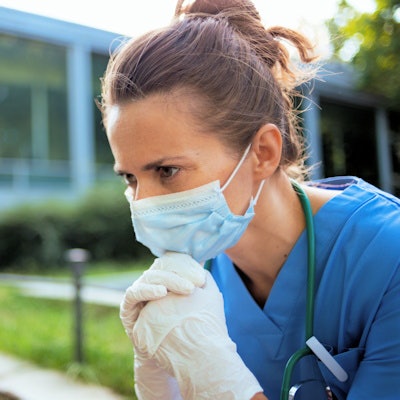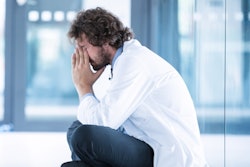
Even before the pandemic, breast imagers had high self-reported levels of burnout. But the COVID-19 pandemic didn't make it worse, according to findings published July 20 in European Journal of Radiology Open.
A team led by Jay Parikh, MD, from the University of Texas MD Anderson Cancer Center in Houston found that levels of depersonalization and emotional exhaustion reported by breast radiologists were frequent both before and during the COVID-19 pandemic.
"This may be due to lower volumes of breast imaging work during the pandemic which counterbalanced pandemic-related stressors," the Parikh team wrote.
It's no secret that burnout continues to be a challenge among radiologists in all specialties, with professionals contemplating leaving the field altogether because of it. While the COVID-19 pandemic led to an overall initial decrease in operational volumes with practices being temporarily closed, this was followed by a rebound effect. This meant practices had to deal with backlogs of patient studies.
Previous survey-based research outlined stressors affecting breast radiologists following the pandemic. Parikh and colleagues hypothesized that burnout would have worsened among these radiologists during the pandemic compared to beforehand. The researchers wanted to compare burnout and stressors experienced by breast radiologists before and during the pandemic.
They included survey data from 261 members of the Society of Breast Imaging. The survey was conducted in January 2021 during the pandemic. Out of the total respondents, 194 (74%) were female and 106 (41%) had more than 20 years of experience. The researchers also employed a points-based scale ranging from 1 to 6 points. A score of 1 indicated strong disagreement, while a score of 6 meant strong agreement.
The team found that respondents reported nearly identical levels of burnout constructs for the 2019 and 2020 years. This included scores of 2.2 for depersonalization and 5.3 for the feeling of personal accomplishment. Additionally, the emotional exhaustion score decreased slightly from 3.5 in 2019 to 3.4 in 2020. All reported scores did not achieve statistical significance.
The group also noted that most self-reported stressors significantly decreased with the onset of the pandemic.
| Comparison of frequency of stressors before, during COVID-19 pandemic | |||
| Self-reported stressor | 2019 | 2020 | p-value |
| Financial situation in serious strain | 1.2 | 1 | 0.001 |
| Prospect of losing job or not finding suitable job | 1.4 | 1.1 | 0.011 |
| Wishing to work outside of medicine | 1.4 | 1.4 | 0.83 |
| Providing care for dependents | 2 | 1.7 | 0.0034 |
| Working in medicine is major stress | N/A | 2.4 | N/A |
| Working more hours than wanting to | N/A | 2.5 | N/A |
| Practicing faster due to higher imaging workloads | 2.9 | 2.6 | 0.011 |
| Work/life balance | 2.7 | 2.5 | 0.038 |
Despite these results, the respondents perceived these stresses had gotten slightly worse since the pandemic (p < 0.01). The researchers suggested that this could be because of physiological dysregulation, respondents judging the past disproportionately more positively than when judging the present, and perceived stress being readjusted relative to the heightened stress and demands experienced by colleagues in other medical areas.
Additionally, the team found that 49.8% of respondents (n = 130) reported considering leaving their current practice. The respondents cited work/life balance as the most common reason for leaving (n = 82, 63%), followed by clinical workload (n = 65, 50%) and interpersonal or cultural issues (n = 44, 34%). Of those thinking of leaving, 61% cited two or more reasons for doing so.
The study authors suggested that based on their results and those of previous reports, there are factors that are "uniquely" inherent within radiology that place professionals at risk for burnout.
They also called for further research to longitudinally evaluate burnout among breast radiologists now that imaging volumes have rebounded.
The study can be found in its entirety here.




















